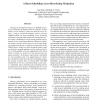Free Online Productivity Tools
i2Speak
i2Symbol
i2OCR
iTex2Img
iWeb2Print
iWeb2Shot
i2Type
iPdf2Split
iPdf2Merge
i2Bopomofo
i2Arabic
i2Style
i2Image
i2PDF
iLatex2Rtf
Sci2ools
HPCA
2007
IEEE
2007
IEEE
A Burst Scheduling Access Reordering Mechanism
Utilizing the nonuniform latencies of SDRAM devices, access reordering mechanisms alter the sequence of main memory access streams to reduce the observed access latency. Using a revised M5 simulator with an accurate SDRAM module, the burst scheduling access reordering mechanism is proposed and compared to conventional in order memory scheduling as well as existing academic and industrial access reordering mechanisms. With burst scheduling, memory accesses to the same rows of the same banks are clustered into bursts to maximize bus utilization of the SDRAM device. Subject to a static threshold, memory reads are allowed to preempt ongoing writes for reduced read latency, while qualified writes are piggybacked at the end of bursts to exploit row locality in writes and prevent write queue saturation. Performance improvements contributed by read preemption and write piggybacking are identified. Simulation results show that burst scheduling reduces the average execution time of selected SPE...
Access Reordering Mechanism | Burst Scheduling Access | Computer Architecture | HPCA 2007 | Order Memory Scheduling |
| Added | 01 Dec 2009 |
| Updated | 01 Dec 2009 |
| Type | Conference |
| Year | 2007 |
| Where | HPCA |
| Authors | Jun Shao, Brian T. Davis |
Comments (0)

